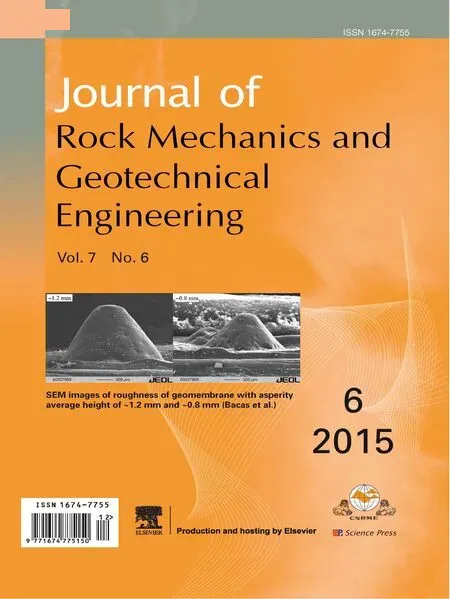Feasibility study of tar sands conditioning for earth pressure balance tunnellingD.Martinellia,*,D.Peilaa,E.Campab
2015-10-09DIATIPolitecnicodiTorinoCorsoDucdegliAbruzzi24Torino10129Itly
DIATI-Politecnico di Torino,Corso Duc degli Abruzzi 24,Torino,10129,Itly
bAstaldi SpA,Via G.V.Bona 65,Roma,00156,Italy
Feasibility study of tar sands conditioning for earth pressure balance tunnellingD.Martinellia,*,D.Peilaa,E.Campab
aDIATI-Politecnico di Torino,Corso Duca degli Abruzzi 24,Torino,10129,Italy
bAstaldi SpA,Via G.V.Bona 65,Roma,00156,Italy
A R T I C L E I N F O
Article history:
in revised form
1 September 2015
Accepted 10 September 2015
Available online xxx
Tunnelling
Earth pressure balance(EPB)
Soil conditioning
Tar sands
Laboratory test
A B S T R A C T
This paper presents the results of laboratory test on the feasibility of soil conditioning for earth pressure balance(EPB)excavation in a tar sand,which is a natural material never studied in this respect.The laboratory test performed is based on a procedure and methods used in previous studies with different types of soils,but for this special complex material,additional tests are also conducted to verify particular properties of the tar sands,such as the tilt test and vane shear test usually used in cohesive materials,and a direct shear test.The laboratory test proves that the test procedure is applicable also to this type of soil and the conditioned material can be considered suitable for EPB excavations,although it is necessary to use a certain percentage of fine elements(filler)to create a material suitable to be mixed with foam.The test results show that the conditioned material fulfils the required standard for an EPB application.
©2015 Institute of Rock and Soil Mechanics,Chinese Academy of Sciences.Production and hosting by
Elsevier B.V.All rights reserved.
1.Introduction
Earth pressure balance(EPB)shield machines have been used for tunnelling excavation in many different types of soils thanks to the use of soil conditioning agents.These agents modify the properties of the soil into that of a plastic paste,thus permitting the homogeneous flow of the excavated soil from the tunnel face through the bulk chamber and the screw conveyor,the optimal control of the face pressure,the creation of spoil suitable to be transported on a conveyor belt,the prevention of water inflow,the reductions of the cutter head and screw conveyor torque and of the friction between metallic parts and the soil and,finally,the reduction of wear(Merritt and Mair,2006;Vinai et al.,2007;Borio et al.,2010;Thewes and Budach,2010;Herrenknecht et al.,2011;Barbero et al.,2012;Peila,2014).Several studies have investigated the possibility of conditioning and the chemical materials to be used in different types of soils,mainly subdivided into three groups:cohesionless soils(sand and gravel),silts and clays,and rock masses.The various researches have set up different laboratory procedures for these achievements before and after soil conditioning,as stated in Peila(2014)and Thewes and Budach(2010)for cohesionless soils,in Thewes and Burger(2005),Zumsteg et al.(2012)and Hollmann and Thewes(2013)for clay,in Peila et al.(2013)and Martinelli et al.(2015)for rock mass.
All these researches suggested that before the EPB shield starts to work,it is strongly recommended to carry out laboratory tests to check if the soil can or cannot be conditioned and to provide an estimate of the conditioning agent types(mainly foam and polymers)and sets.Sometimes the use of fillers is required in order to artificially modify the particle size distribution of the natural soil, thus allowing the conditioning agents to work properly.These fillers are usually bentonite or carbonate submillimetric particles mixed in the soil as slurries.
Excavation through layers of tar sands,which are sandy soils containing a variable amount of hydrocarbons,is a rare but very critical case in some areas in the world,such as in the Metro of Los Angeles,and it has never been studied with reference to the EPB tunnelling conditioning process.Understanding the conditioning of this type of complex material at laboratory scale assumes an interesting scientific and technical aspect.This assessment can be done using as a reference the same procedure used for other types of soils,but taking into account the specificity of this natural material(the hydrocarbon content and its interference with the conditioning agents,influence of temperature,etc.).
The mechanical behaviour of the tar sand is temperaturedependent and its rheology is influenced by the tar content and properties,which can interact with the conditioning material in different ways.Moreover,the infusion of tar reduces the permeability of the material transforming the sand,which can usually be easily mixed with the foam(Milligan,2000;Merritt et al.,2003;Peila et al.,2007;Vinai et al.,2007;Thewes and Budach,2010;Zumsteg et al.,2013a,b)into a stronger material similar to acold-mix asphalt mixture(Anochie-Boateng and Tutumluer,2009, 2012).This aspect can be problematic in the conditioning process, since the reduced capability of the material to absorb and to be mixed with liquids and foam prevents the creation of a material suitable for EPB tunnelling,and this is the main goal of the research.
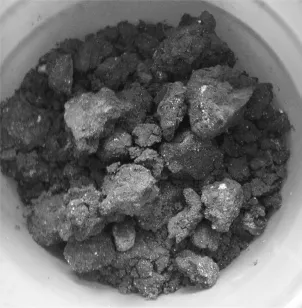
Fig.1.Picture of the soil tested in the laboratory.It is possible to see the sand aggregated in blocky elements.
2.Laboratory test
The test methods and interpretation schemes usually used have been updated and improved in this research,and the testprocedure has been applied to tar sand samples to check its feasibility.
2.1.Soil tested
The soil tested in the laboratory is a natural sand with a relevant tar infusion(Fig.1).It was initially tested for bitumen content(AASHTO T 308-10,2010)whichwas found tobe equal to13%,while the water content is 1.4%.After separating the bitumen from the sand by burning it in a furnace,washed sieve analysis tests were conducted to determine particle size distributions,as shown in Fig.2(ASTM D422-07,2007).The sand is uniformly graded from fine to medium with particle sizes ranging from 0.01 mm to 5 mm.
2.2.Test procedure
The laboratory studies were carried out on the natural tar sands following an already established procedure(Peila,2014),but,for this special case,as the temperature at tunnel depth is expected to be up to 45°C,tests were conducted also on heated material.At this temperature,the natural material becomes more fluid and the cementation effect of the grains is reduced due to the partial melting of the tar in the mass(Fig.3).
The first step of the research consists of determining the best conditioning parameters through a slump test,which can be assessed by a fall to the cone of the magnitude of 15-20 cm,and a reduced release of water and foam from the mass is required.A comparative table for the qualitative assessment of the mix was developed by Peila et al.(2009),as reported in Fig.4.
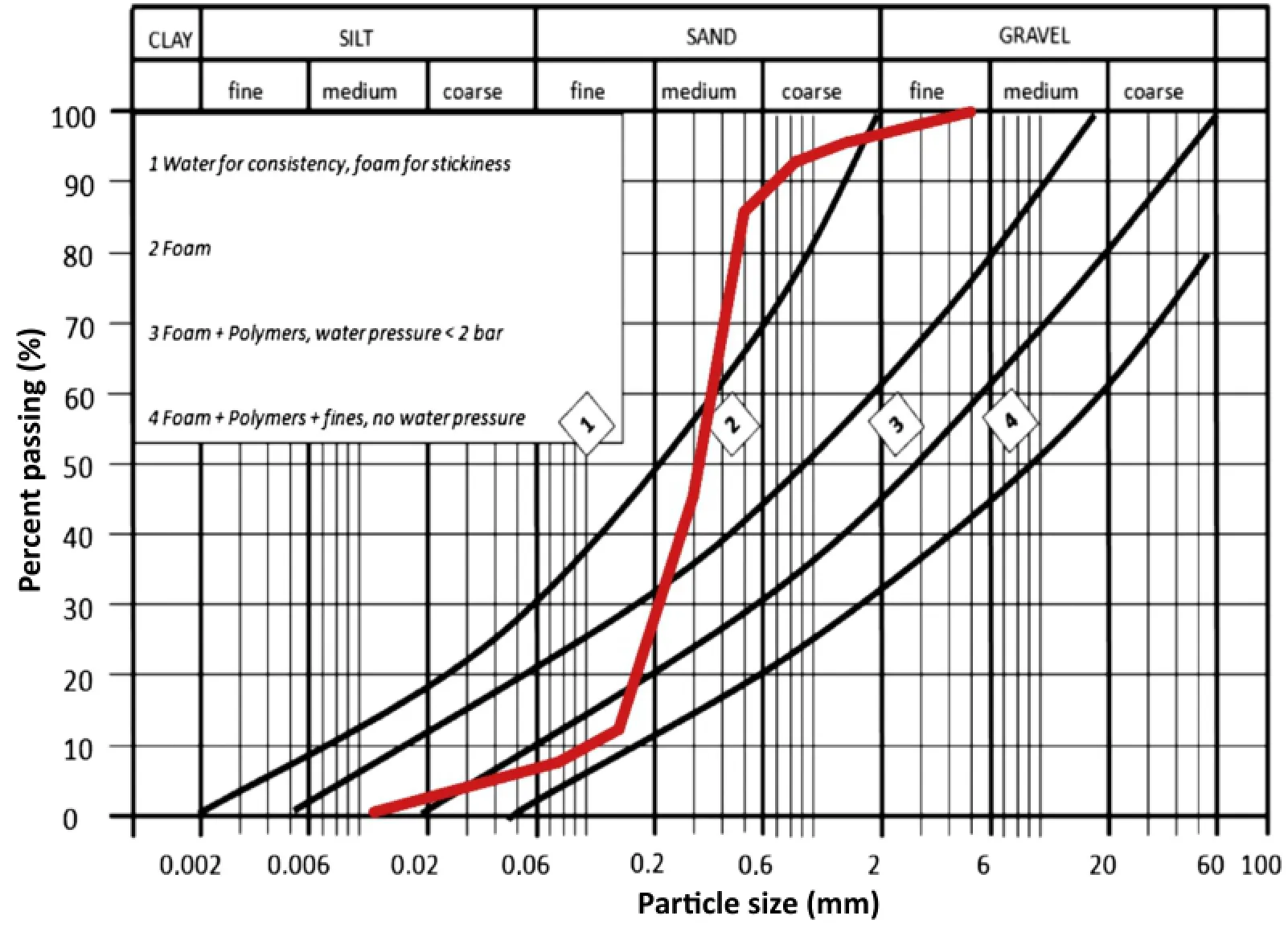
Fig.2.Particle size distribution of the sand compared with the range of application of EPB(1 bar=100 kPa)(Herrenknecht et al.,2011).
The most important parameters to investigate and assess soil conditioning are:(i)the foam injection ratio(FIR),representing the percentage in volume of foam added to the soil;(ii)the foam expansion ratio(FER),representing the ratio between the obtained volumeoffoamandthevolumeofgenerationfluid(water+foaming agent);(iii)the percentage of free water added to the material(wadd);and(iv)the slurry injection ratio(SIR),representing the percentage in volume of slurry/filler added to the soil.
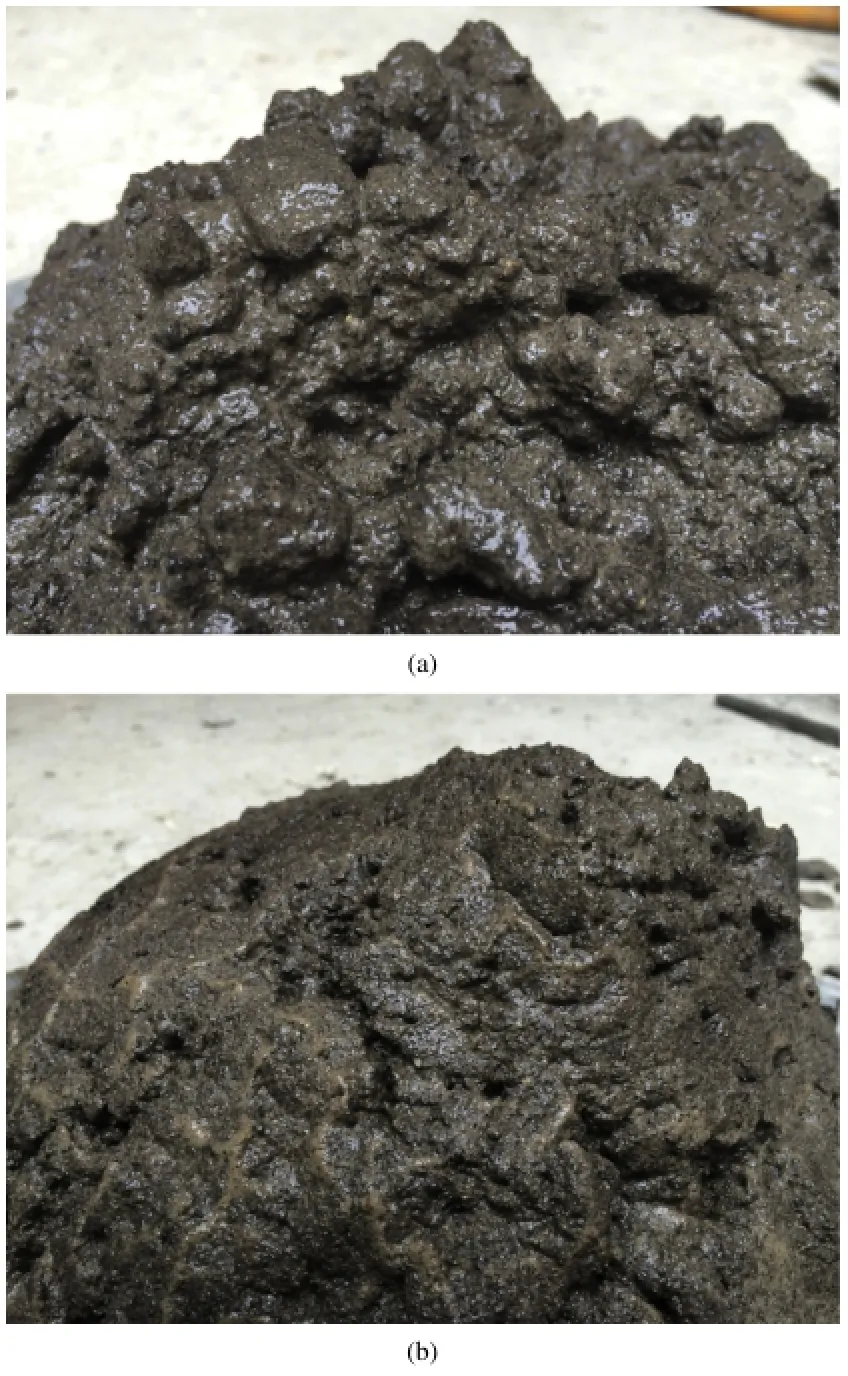
Fig.3.Example of conditioned soil with a conditioning set that gave an optimal slump with foam C at 20°C(a)and 45°C(b).The pictures show the difference of behaviour of the conditioned masses.At higher temperature,the material in(b)appears more pasty and with less large elements.
The foam for this research is produced with the foam generator devicealready describedinVinaietal.(2007)andPeilaetal.(2009). The foaming agents(surfactants)used are three standard commercial products,named A,B and C.To produce the conditioned sample and perform the slump test requires the following steps:
(1)A quantity of 7-8 kg of soil is placed in the mixing device.
(2)A quantity of filler/polymer/bentonite suspension(previously mixed with a mechanical stirrer)and water is added to the soil as required in the conditioning set to be tested.
(3)The foam with the required FER is mixed with the soil at the FIR to be tested.
(4)The material obtained is then placed in a standard Abrams cone(ASTM C143-12,2012)which is lifted immediately.The drop of the material is then measured and the required technical aspect of the mass is checked in order to verify the actual result of the test as assessed by Peila et al.(2009).Avane test is then carried out in the conditioned soil.
Moreover,the particular mechanical behaviour of the studied material required additional tests in order to assess the suitable conditioning.To verify the adhesion between the soil and the metallic part,a tilt test procedure to assess the tilt angle value was used(Fig.5):
(1)The sample is placed between the tilt plane and an aluminium element(100 mm×100 mm),in order to create an interface between the two metal plates.
(2)The block is loaded for 1 min with two loads of 3 kg and 10 kg(equivalent to a normal pressure of 3 kPa and 10 kPa).
(3)The plane is gradually tilted until sliding of the block occurs.
As the presence of the tar transforms the sand,which is usuallya frictional medium,into a pseudo-cohesive material,a field vane shear tester as shown in Fig.6(ASTM D2573-08,2008)was used to evaluate the undrained shear strength of the natural and conditioned soils immediately after the slump test.For this test the material was inserted into a cylindrical steel container and pressed for 1 minwith a pressureof 10 kPa.This testgives rapidlyimportant indications of the shear strength of the conditioned material,which has to be as low as possible for the EPB tunnelling process.
Finally,for the most suitable conditioning set chosen according to the previously described tests,a direct shear test was performed(ASTM D3080-11,2011)in order to confirm the obtained results and the mechanical behaviour of the conditioned mass when referring to the natural soil.
2.3.Discussion of test results
Slump tests with different values of wadd,FIR,FER and SIR and with the addition of three different commercial conditioning products were carried out to verify the conditioning possibility of the studied tar sand.The most important results are summarized in Tables 1 and 2.It is possible to assess that the studied tar sand at room temperature(20°C)has a granular shape and a reduced number of free fine-grained elements,since they are bonded together by the bitumen(Fig.1).This condition is a critical aspect since the finest grains are the soil elements that interact with the foam bubbles to get the required conditioned performances,as demonstrated by different studies(Merritt and Mair,2006;Vinai et al.,2007;Thewes and Budach,2010).
An increase of temperature allows a certain number of finer grains to separate from the larger elements but not at a sufficient level to allow an optimal conditioning with only foam(this result depends on the bitumen content).When the samples are tested at 45°C,they appear,as expected,more fluid and the conditioning process works better compared to the ones at 20°C(Fig.3).
The addition of water does not allow conditioning of the material,as can be observed with some types of clays in Peila(2014). Therefore conditioning must be done in a different way.The slump tests carried out with the use of foam only(i.e.SIR=0%)both at 20°C and after the soil has been heated at 45°C,for all the tested foaming agents,showed that the foam tends to escape from the mass and has a reduced effect in the creation of the plastic paste. This result cannot be considered completely general across all the possible variations of the soil samples(soil particle size distribution and bitumen content)that can occur at real sites,since it depends on the bitumen content and on the percentage of fine grains.The limited quantity of fine grains can be bypassed with the addition of bentonite filler(SIR>0%).The tests carried out with the addition of filler and foam together(both at room temperature and when the soil was heated)allowed us to obtain a good plasticity and a regular slump in the tested samples.
The best conditioning in the 20°C test is achieved when an SIR of 15%is considered with bentonite content in the slurry ranging from 15%to 20%and an amount of foam with a FIR of 15%-20%for all the three tested foaming agents,while at the temperature of 45°C easier and better conditioning can be obtained with the same set of conditioning parameters.
These results are confirmed by the vane shear tests,from which it is possible to see that at 45°C the natural material has a shear strength of 8 kPa,and with the combination of bentonite+foam(for all tested products)this value is about 2 kPa.Whenconsidering the test at the temperature of 20°C,it is possible to see a similar trend,but the shear strength values are higher. Similar behaviour can be observed with reference to the tilt angle. The addition of the conditioning agents reduces this value from 33°to 28°(compacted at 3 kPa)at 45°C and from 66°to 41°(compacted at 10 kPa)at 20°C.At 45°C,there is no significant difference in the measured tilt angles between the conditioned and natural states,because the viscosity of the tar is the dominant parameter.Furthermore,it can be observed that the studied soil(with its specific content of bitumen),after conditioning,is less sticky on a metallic surface than the natural one,e.g.clay(Zumsteg et al.,2013a,b).
The direct shear tests on the natural soil and the conditioned soil clearly showed that the conditioning process reduces the shear strength of the material(Fig.7).
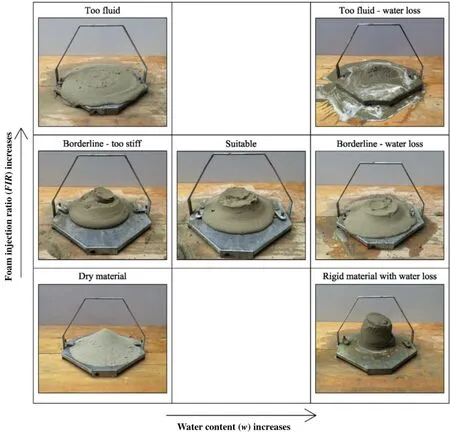
Fig.4.Assessed diagram of slump test quality as prepared by Peila et al.(2009)(updated).
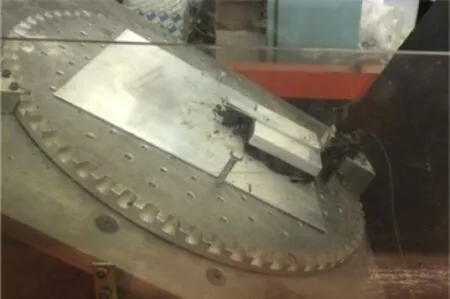
Fig.5.Tilt test apparatus.
3.Conclusions
The conditioning for EPB tunnelling in tar sands is a complex task since this material is a mixture of soil and bitumen,which waterproof the ground.Furthermore,the study has shown thegreat importance of temperature for varying the mechanical behaviour of the mass.
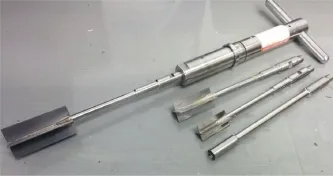
Fig.6.Vane shear test apparatus.

Table 1 Results of the conditioned tests.

Table 2 Results of the slump test on the most significant conditioning sets.
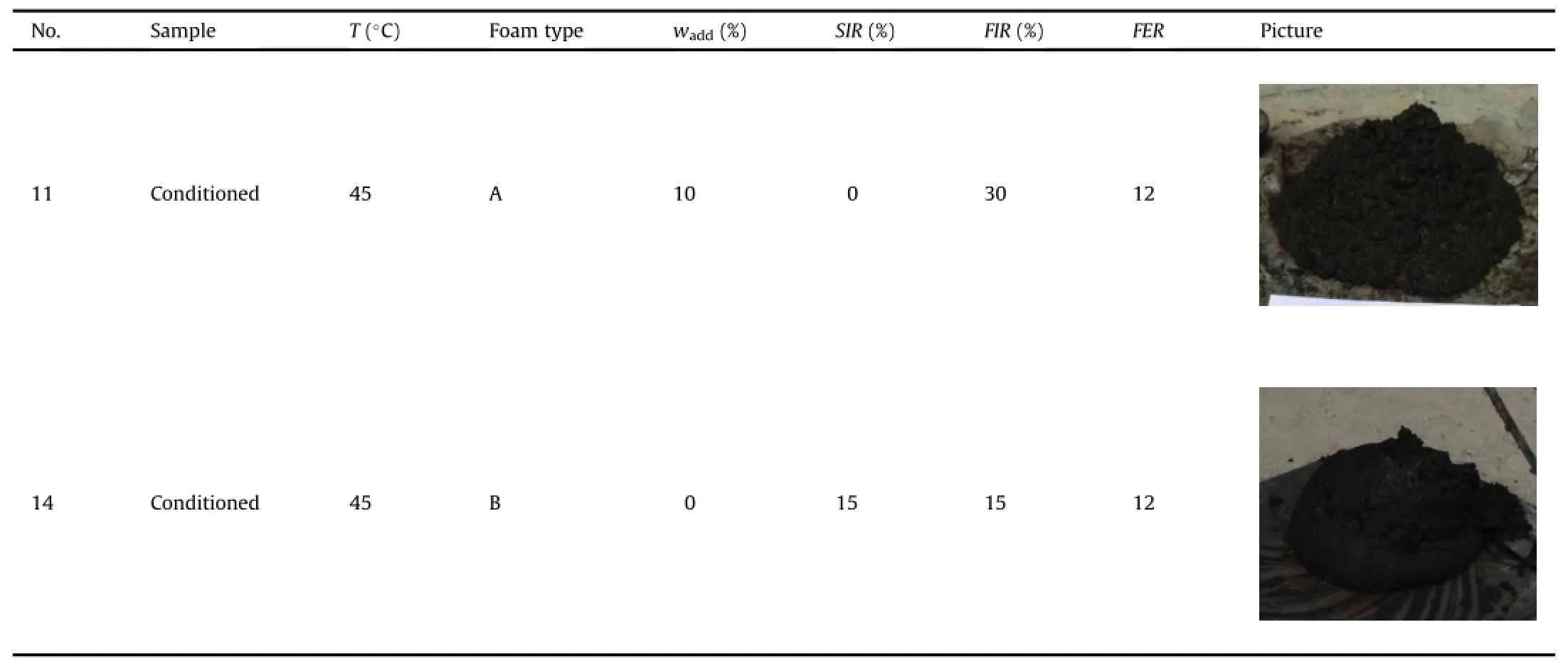
Table 2(continued)

Fig.7.Failure envelope of the natural and conditioned tar sands for the conditioning set#14.
The test results show that conditioning with foam reduces the shear strength of the mass,although the addition of foam is not sufficient for obtaining an optimal behaviour referring to EPB tunnelling.In this case,the addition of filler(bentonite)is needed in order to create a suitable mass.
Finally,we can assess that the studied tar sand is suitable for excavation with an EPB machine,according to the general characteristics required by the soil for this technological application.The developed tests were shown to be effective for this assessment,but tests at high temperature still have to be considered and carried out to have a complete overview of the soil behaviour when tunnelling in this soil.
Conflict of interest
The authors confirm that there are no known conflicts of interest associated with this publication and there has been no significant financial support for this work that could have influenced its outcome.
Acknowledgements
This research is a by-product of a research contract between Politecnico di Torino and Astaldi SpA(Rome,Italy).Special thanks are given toengineer Mattia Ghigo,who cooperatedin this research within his MSc thesis work.
References
AASHTO T 308-10.Standard method of test for determining the asphalt binder content of hot mix asphalt(HMA)by the ignition method.Washington D.C., USA:American Association of State Highway and Transportation Officials;2010.
Anochie-Boateng J,Tutumluer E.Characterizing volumetric deformation behavior of naturally occuring bituminous sand materials.In:Proceedings of the 7th International RILEM Symposium on Advanced Testing and Characterization of Bituminous Materials.International Society for Rock Mechanics;2009.p.1-10.
Anochie-Boateng J,Tutumluer E.Sustainable use of oil sands for geotechnical construction and road building1540.ASTM Special Technical Publication;2012. p.73-94.
ASTM C143-12.Standard test method for field vane shear test in cohesive soil.West Conshohocken,PA,USA:ASTM International;2012.
ASTM D2573-08.Standard test method for field vane shear test in cohesive soil. West Conshohocken,PA,USA:ASTM International;2008.
ASTM D3080-11.Standard test method for direct shear test of soils under consolidated drained conditions.West Conshohocken,PA,USA:ASTM International;2011.
ASTM D422-07.Standard test method for particle-size analysis of soils.West Conshohocken,PA,USA:ASTM International;2007.
Barbero M,Peila D,Picchio A,Chieregato A,Bozza F,Mignelli C.Procedura sperimentale per la valutazione dell'effetto del condizionamento del terreno sull'abrasione degli utensili nello scavo con EPB.Geoingegneria Ambientale e Mineraria 2012;135(1):13-9(in Italian).
Borio L,Chieregato A,Picchio A,Peila D.Studio della permeabilità di terreni condizionati con schiume.Geoingegneria Ambientale e Mineraria 2010;130(2):75-80(in Italian).
Herrenknecht M,Thewes M,Budach C.The development of earth pressure shields:from the beginning to the present.Geomechanics and Tunnelling 2011;4(1):11-35.
Hollmann F,Thewes M.Assessment method for clay clogging and disintegration of fines in mechanised tunnelling.Tunnelling and Underground Space Technology 2013;37:96-106.
Martinelli D,Chieregato A,Onãte Salazar CG,Barbero M,Peila D.Conditioning of fractured rock masses for the excavation with EPB shields.In:Proceedings of the 13th International Congress of Rock Mechanics.International Society for Rock Mechanics;2015.
Merritt A,Borghi F,Mair R.Conditioning of clay soils for earth pressure balance tunnelling machines.In:Proceedings of Underground Construction2003;2003. p.455-66.
Merritt A,Mair R.Mechanics of tunnelling machine screw conveyors:model tests. Géotechnique 2006;56(9):605-15.
Milligan G.State-of-the-art review:Lubrification and soil conditioning in tunnelling,pipe jacking and microtunnelling.London,UK:Geotechnical Consulting Group;2000.
Peila D,Oggeri C,Borio L.Using the slump test to assess the behavior of conditioned soil for EPB tunneling.Environmental&Engineering Geoscience 2009;15(3):167-74.
Peila D,Oggeri C,Vinai R.Screw conveyor device for laboratory tests on conditioned soilforEPBtunnelingoperations.JournalofGeotechnicalandGeoenvironmental Engineering 2007;133(12):1622-5.
Peila D,Picchio A,Chieregato A.Earth pressure balance tunnelling in rock masses:laboratory feasibility study of the conditioning process.Tunnelling and Underground Space Technology 2013;35:55-66.
Peila D.Soil conditioning for EPB shield tunnelling.KSCE Journal of Civil Engineering 2014;18(3):831-6.
Thewes M,Budach C.Soil conditioning with foam during EPB tunnelling.Geomechanics and Tunnelling 2010;3(3):256-67.
Thewes M,Burger W.Clogging of TBM drives in clay-identification and mitigation of risks.In:Underground Space Use:Analyses of the Past and Lessons for the Future.London,UK:Taylor&Francis Group;2005.p.737-42.
Vinai R,Oggeri C,Peila D.Soil conditioning of sand for EPB applications:a laboratory research.Tunnelling and Underground Space Technology 2007;23(3):308-17.
Zumsteg R,Plötze M,Puzrin A.Effect of soil conditioners on the pressure and ratedependent shear strength of different clays.Journal of Geotechnical and Geoenvironmental Engineering 2012;138(9):1138-46.
Zumsteg R,Plötze M,Puzrin A.Effects of dispersing foams and polymers on the mechanical behaviour of clay pastes.Géotechnique 2013a;63(11):920-33.
Zumsteg R,Plötze M,Puzrin A.Reduction of the clogging potential of clays:new chemical applications and novel quantification approaches.Géotechnique 2013b;63(4):276-86.

Daniele Martinelli is currently a Ph.D.candidate in Georesources and Geo-technologies at Department of Environment,Land and Infrastructure Engineering of Politecnico di Torino.He holds a Master's Degree in Environmental Engineering from the same University.He spent 1 academic year in School of Engineering,Aalto University in Espoo,Helsinki,improving his knowledge on Scandinavian rock masses.His main research interests include the study of soil and rock mass conditioning for EPB applications, especially regarding the geotechnical characterization of the conditioned material.He is now focussing on the reduction of the shear strength on granular soils due to the conditioning process.He is also involved in several tunnelling and mining consultancies within his research group,including conditioning laboratory tests for EPB application feasibility and numerical simulations.He has been working also as project engineer at Rockplan,located in Helsinki,Finland since 2010.His role within the company includes numerical modelling of hard rock excavations,including studies of deep crystalline rock mass behaviour in high stress conditions for nuclear waste disposal applications.He is member of the International Society for Rock Mechanics since 2011 and member of the International Society for Soil Mechanics and Geotechnical Engineering since 2012.
14 July 2015
*Corresponding author.Tel.:+39 0110907703.
E-mail address:daniele.martinelli@polito.it(D.Martinelli).
Peer review under responsibility of Institute of Rock and Soil Mechanics,Chinese Academy of Sciences.
1674-7755©2015 Institute of Rock and Soil Mechanics,Chinese Academy of Sciences.Production and hosting by Elsevier B.V.All rights reserved.
http://dx.doi.org/10.1016/j.jrmge.2015.09.002
杂志排行
Journal of Rock Mechanics and Geotechnical Engineering的其它文章
- Evolution process of rock mass engineering system using systems science
- Revisiting the Bjerrum's correction factor:Use of the liquidity index for assessing the effect of soil plasticity on undrained shear strength
- Hydraulic mechanism and time-dependent characteristics of loose gully deposits failure induced by rainfall
- A distributed measurement method for in-situ soil moisture content by using carbon-fiber heated cable
- Load eccentricity effects on behavior of circular footings reinforced with geogrid sheets
- Studies on the key parameters in segmental lining design
